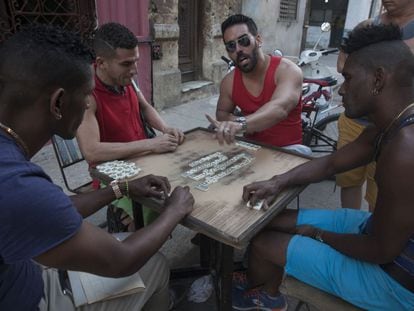Obama arrives in Cuba to seal the thawing of diplomatic relations
US president to meet Raúl Castro, business leaders and dissidents during historic visit

A sitting US president set foot in Cuba for the first time in 88 years on Sunday.
Barack Obama, who won the 2008 presidential election on the pledge to engage in talks with enemy nations, touched down at 4.19pm local time at José Martí airport in Havana.
Obama did not come to ask Cuban leader Raúl Castro for political change in one of the world’s longest-running authoritarian regimes. Nor is he being received with hostility: rather on the contrary. The Caribbean island is one of the few bastions of Obamamania, and the US president wants to use that to cement the reconciliation between both countries.
Obama has said his visit is a “historic” one, but also just “a first step” in the new relationship between both nations. At a meeting with staff at the US embassy in Havana, the US leader recalled that “nearly 90 years have elapsed since a US president was in Cuba.”
This is a historic visit and it’s a historic opportunity to engage directly with the Cuban people Barack Obama
“It is wonderful to be here,” he added. “This is our very first stop. This is a historic visit and it’s a historic opportunity to engage directly with the Cuban people.”
Up until a few months ago, the idea of a US president walking triumphantly into Havana was still classified as one of the Castro regime’s worst nightmares. Meanwhile, just hearing the surname Castro made many in Washington and Miami – headquarters of the Cuban exile – break out in hives. The vision of a US president visiting a member of the Castro family inside Revolution Palace in Havana seemed like science fiction.
The 48-hour visit is the climax of a year’s worth of work to normalize relations after more than half a century of cold war. The change was made possible by an African-American who was born in 1961, when the Cuban revolution was just two years old, and by an old revolutionary and military man born in 1931.
Over the course of this year, the US and Cuba have reopened their embassies, and Washington has eased the conditions for business and travel to the island. The thaw has been so fast that what seemed unimaginable a year-and-a-half ago feels natural today.
Obama’s schedule, besides a speech and a talk with Raúl Castro on Monday – though not with his brother Fidel – includes meetings with entrepreneurs and dissidents, as well as a baseball game. Obama arrived in the company of First Lady Michelle, his daughters Sasha and Malia, and his mother-in-law Marian Robinson.
The idea is that by improving the lives of everyday Cubans, the country will eventually transform itself
“For Cubans, the president’s visit validates the revolution,” says Peter Kornbluh, co-author of Back Channel To Cuba: The Hidden History of Negotiations Between Washington and Havana. The most recent edition of the book includes a detailed look at the conversations that led to the announcement of restored relations made on December 17, 2014 by Obama and Castro.
“The point of view of the United States is the following,” says Kornbluh. “We will build cultural, economic, political bridges between both societies. And the enormous influence of the American system will cross these bridges.”
Applied to Cuba, the Obama foreign policy doctrine holds that political change – democracy, a multi-party system, freedom of the press – cannot be imposed from the outside. Obama is not seeking to change the regime, neither here nor in Iran. The idea is that by improving the lives of everyday Cubans, the country will eventually transform itself. The more tourists and students visit the island, and the more business is conducted between both nations, the closer the island will get to democratization.
On Tuesday, when he delivers his key address, Obama will make it clear that it is up to the Cuban people, and nobody else, to decide their own future. But he will not silence his own opinion.
Last December, Obama said that it made no sense to visit Cuba if there was no observable progress on the human rights front. This progress is still not visible, yet Obama is visiting the island anyway.
“Evidently, he changed his mind,” says Jorge Domínguez, an expert in international affairs who teaches at Harvard. “Instead of saying ‘I’m going to wait until human rights progress becomes palpable,’ my impression is that he said to himself: ‘I don’t have a lot of time. And if I want change to happen in Cuba, I have to go see Raúl Castro and tell him: ‘Hey, what’s going on? I can’t do this alone.”
With just 10 months to go before a new president takes over, Obama wants to make sure that the thaw is irreversible
And with just 10 months to go before a new president takes over at the White House – a president who could undo the progress of the past year – Obama wants to make sure that the thaw is irreversible.
A Republican president could put everything into reverse if he wanted to, notes Elliott Abrams, a veteran of the Bush administration and a reference within the neoconservative movement.
“My main objection to Obama’s policy is that, unlike Burma, where we made demands before lifting the sanctions, we have given Castro everything in exchange for nothing. Human rights in Cuba are worse today than they were a year ago.”
Abrams thinks that comparisons between Obama’s trip to Cuba and Nixon’s visit to China in 1972 or Bill Clinton’s trip to Vietnam in 2000 are inaccurate.
“In Vietnam we had a war with 50,000 dead. China, after all, is a great power. Cuba is small and it has a small economy,” he says. “I think that for Obama, this is mostly a vanity trip: he will meet with Castro and the press will love it, but the effects will be very reduced.”
English version by Susana Urra.












































